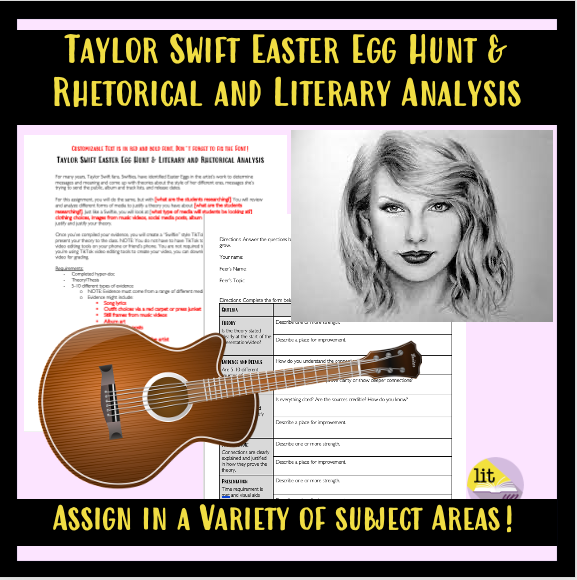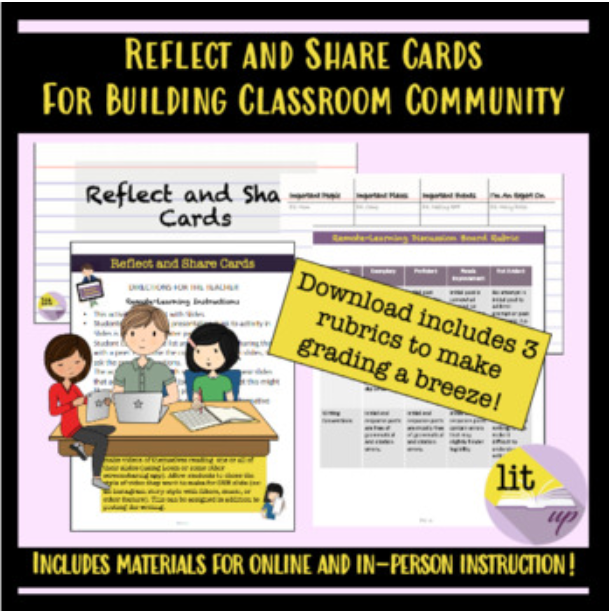- Be a #SwifttokDetective in the English Classroom
Use this fun activity to get students excited about thesis and persuasive writing.

Photo by Raphael Lovaski on Unsplash It Started On My FYP
I’m not ashamed to admit that I freaking love TikTok.
My feed is mostly DIY house projects, cooking, witchcraft (more on this another time), astrology, and #Swifttok.
For those of you who aren’t on TikTok, the thing that makes TikTok amazing is the “For You Page.” The algorithm knows what users like and what they are interested in. Before you know it, it’s like you’re in a casino. You have no idea what time it is, but you’ve bookmarked 12 recipes you’re never going to try and 5 house projects that you will do, even if it means challenging the limits of your marriage.
While my FYP has included a lot of Taylor Swift content, ever since the announcement of her new upcoming album release of Midnights on October 21, I’ve been seeing a lot, and I mean a lot of TikToks.
At the start, the content of the videos focused mostly on when she’d release a single. This was a shift from the literary analysis that many of the videos included where creators were deep diving into her work to support theories that Taylor may have actually been dating her friend Karlie Kloss.
At first, I thought these videos were fun, though maybe a little unhinged, but at some point, I found myself hooked. I wanted all the Taylor Swift TikTok content.
Then the English teacher in me realized why I wanted more of these videos.
Y’all, these Swifties, are doing some pretty incredible explications on Swift’s body of work. Not only were they including the lyrics from her songs, but they were pulling evidence from music videos, social media posts, red carpet fashion choices, interview appearances, and so much more. It was incredible to see them justify their theories and make connections.
Here’s an example by @calla_theswiftie. She does a great job of opening with her theory and then references different media to support her theory.
The first time I saw this, I couldn’t help, but think, isn’t this what all English teachers dream about when they assign a text?
And, well, because I’m always in teacher mode, this assignment was born.
#Swifttok, Textual Analysis, and Persuasion
This activity is quite versatile. Students present theories about their favorite singer and examine a wide variety of media to come up with a theory about the artist. Adapt this activity to analyze different types of art and media from a specific historical era to establish a thesis and/or theory about it or a historical figure. This would also work to establish a theory about a poet, fiction writer, or artist.
For instance, students might look at artwork, poems, novel excerpts, and historical events that take place during the Romantic era and create a theory or thesis about the deeper philosophical ideals of the time period.
For a social studies course, students theorize about a historical ficture or perdiod. They analyze the way he/she/they are portrayed in art, and poetry and look at speeches, and historical writings to present a theory/thesis about the historical figure.
Students can complete a character analysis using film clips, quotes from a short story or novel, poems relating to the primary text, literary analysis of the text, artwork portraying a character, biographical information about the writer, interviews of the writer, and so on to establish a theory about the character in a text.
The goal of the activity is to have them look at different types of media and make connections. Context plays a critical role in this activity—which, as I’m sure you know, is critical when being persuasive.
At the end of this activity, students can either create a TikTok video or present using PowerPoint, Google Slides, or whatever other presentation software. Students upload the videos or slides to your LMS for grading. For many students, using the editing tools the TikTok app provides is second nature. This activity allows them to tap into the skills they already have to connect with your content area.
Activity Details
If you’re looking for the materials for this activity. I’ve got you covered. Print or upload this product into whatever LMS you use.
To keep students accountable, students will create a hyperdoc of their resources. The hyperdoc includes a place for students to justify the connections of their evidence.
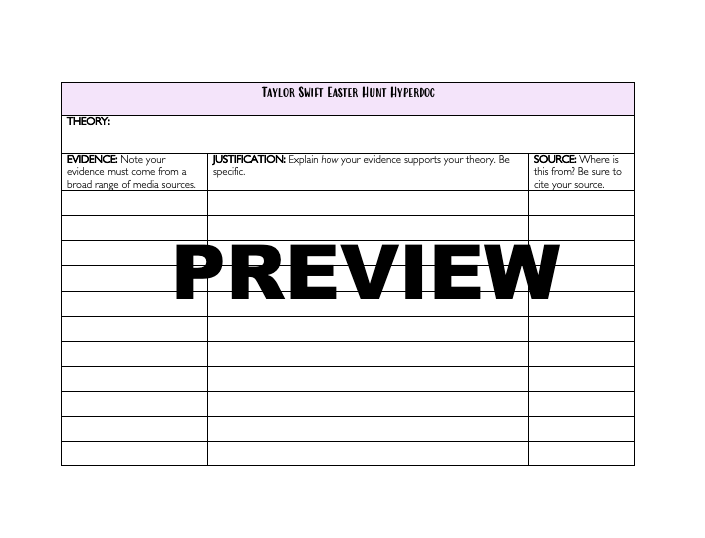
Preview of Lit Up Hyperdoc for Taylor Swift TikTok Theories Activity Students are also provided with assignment guidelines, a checklist, and a peer review activity. Teachers are provided with a grading rubric and a customizable assignment guideline.
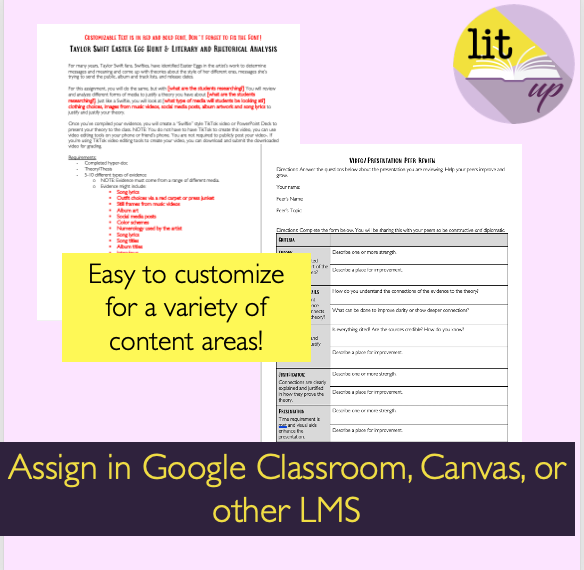
Assignment guidelines can be customized for any content area. The download includes:
- Teacher instructions
- Assignment Guidelines
- Research Hyperdoc
- Assignment Checklist
- Peer Review Activity
- Customizable Assignment Guidelines
- Links to TikToks to use as an example
- Presentation Grading Rubric
Final Thoughts
Whenever I find myself on #Swifttok listening to Swifties analyze not just the lyrics of Taylor Swift’s work but identify the visual connections between the Easter Eggs Swift includes in her music videos, fashion choices, and social media posts, the English teacher in me just lights up.
Let’s meet our students where they are. This is a fantastic activity to make whatever text or topic you’re teaching relatable to students, and it reinforces the importance of context and vetting sources.
Want to try this activity in your classroom? Here is everything you need to make that happen without any prep!
Try it out and let me know what you think.
Did you know I have a newsletter? Check out and subscribe to No Fun Gloria.
Looking for a cozy fall read? My novel, With All My Love, I Wait, is available wherever books are sold.
- A Snow Day Memory

Photo by Ted Sajor on Unsplash Every time it snows, I think of my mother. We don’t get much snow here in Charlotte, but every once in a while, we get a dusting.
Yesterday we got quite a bit and our backyard has some pretty winter wonderland vibes, and I can’t help but think of my mom who would have turned 64 tomorrow.
Here’s a piece that was published a few years ago about my mother and snow and how they are connected.
- Using Stranger Things to Teach Suspense
Your students are tired of reading the same three “scary stories.” It’s time for an upgrade.

Photo by Rick Monteiro on Unsplash Spooky season is here. Sweater weather has arrived. Teachers are getting burnt out!
October is always one of the more grueling teaching months of the year. The students are tired, you’re exhausted, and Thanksgiving break seems really far away.
If you’re looking for an activity to get your students engaged and to give yourself a bit of a break, I’ve got you!
Stranger Things is a popular Netflix series. It hits all us 80s kids with nostalgia, and as a bonus, our students are already watching it.

Stranger Things via Netflix. I love using high-quality film and TV in the classroom. Stranger Things is an incredible text to use in the classroom. It’s rich with details and dynamic characters, and I promise you, the more you watch it, the more you will find. It’s an excellent tool to teach suspense.
My goal when using Stranger Things is to show students the value of watching film and TV without their phones. Engage with the text.
This activity does exactly that.
When teaching suspense, it’s important for students to understand that the plot isn’t the only device that writers are using to add tension.
The Activity
First, students watch the pilot episode of Stranger Things. I’ve included a viewing guide with a key. The viewing guide has 50 questions, making it a great activity to use over the course of a few days.
After students finish the episode students complete a graphic organizer focused on the different locations the episode takes place.
For instance, the students might describe the woods as scary and dark, but the activity does encourage them to think about how the woods is a place where the unknown happens. In literature, it’s often a place where children are in danger. This type of analysis leads them to the next part of the activity where they are justifying and explaining how the choices made by the director impacts the tension and suspense.
Need the viewing guide, key, graphic organizer, and discussion board extension activity? Look no further.
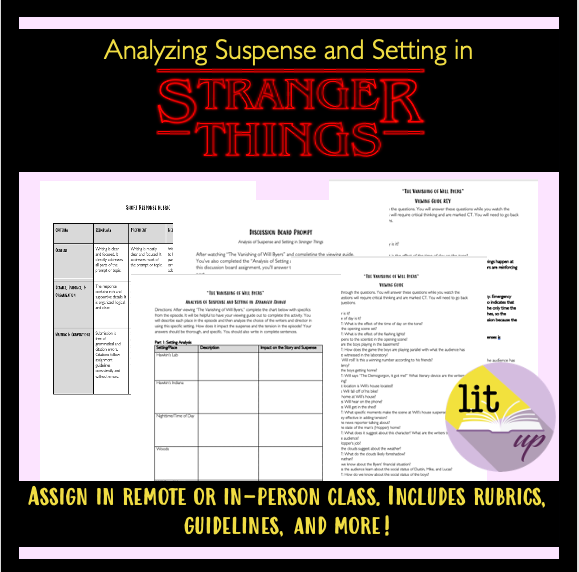
Stranger Things Suspense and Setting Activity via Lit Up Why Use Film or TV?
There are a lot of incredible suspenseful and creepy stories out there, but let me tell you, you’re students have read that Poe story. They read it in 6th grade and 8th grade and 9th grade. When October rolls around, the students know Poe is coming.
I’m not saying you shouldn’t read Poe, I just think it’s more engaging to show them how to analyze a text like the ones they are already engaging with.
Young people love scary movies and shows, and as English teachers, we have the opportunity to show them how much richer the texts are that they are already enjoying. We get to teach them how to be active watchers and readers.
So, save “The Raven” and “The Fall of The House of Usher.” Use this Stranger Things activity first, then have them discuss how the manor in “The Fall of House of Usher” is similar to the Hawkins Lab in “The Vanishing of Will Beyers.” I promise you, the students will be here for it.
Did you know I have a newsletter? It comes into your inbox once a month. Sign up here!
Looking for your next read? Check out my novel, With All My Love, I Wait.
- Mexican Gothic is the Updated Gothic Novel We Need
Add this novel to engage more students and address topics of Colonialism and Feminism in your classroom.
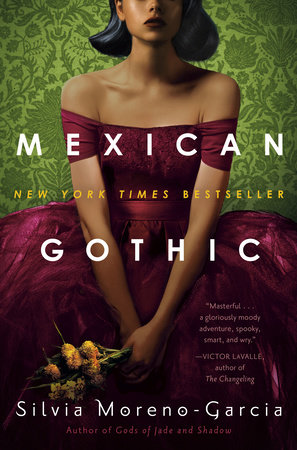
Image courtesy of Penguin. What is Mexican Gothic?
Mexican Gothic, a novel by Silvia Moreno-Garcia is an update of the classic genre often taught in literature classrooms. In the novel, Noemi is sent to help her cousin Catalina. Her cousin might be experiencing a mental breakdown. Noemi arrives at High Place and immediately feels out of place. The Doyles once owned and operated a successful coal mining operation. However, once disease spread through the workforce, killing many natives, and were later flooded, the mines were closed. Like all Gothic novels, Mexican Gothic has super-natural elements, a creepy estate, and a family with lots of secrets.
The prose is spectacular. It’s an English teacher’s dream. There are many passages that are perfect for a deep dive. In addition, Moreno-Garcia makes huge statements about the impacts of Colonialism, making the novel powerful and engaging.
Here are four reasons you should update your classroom library.
Mexican Gothic is a highly engaging text.
For many years, I loved (and still do) teaching Wuthering Heights by Emily Brontë and Rebecca by Daphne Du Maurier. However, for many students, the language, especially in Wuthering Heights, is often a reason for students to check out.
I think we can all agree that Lockwood is insufferable. He opens Wuthering Heights with his narration, forcing teachers to tell students to “Stick with it. It gets better. I promise.” Similarly, with Rebecca, it takes much too long to get to Manderley and meet Mrs. Danvers. I can’t tell you how many times I have told students to just wait until page 50. That’s when it really takes off.
Mexican Gothic is different.
Mexican Gothic, however, takes off right from the start. Immediately, the third-person narrator gets the action going. Noemi’s motives are clear, and because she’s such an engaging character, the audience eagerly follows her to High Place, introduced in the second chapter.
It’s the perfect addition to incorporate lessons for Hispanic Heritage Month.
As Hispanic Heritage Month kicks off today, Mexican Gothic is a perfect addition to the English classroom curriculum. Mexican culture is seamlessly worked into the novel. Audiences unfamiliar with the richness of Mexican culture will be eager to do outside research. For the teaching unit I’ve built, students complete a cultural scavenger hunt as they read. Students can also make connections with the culture and the larger thematic elements.
It’s a more appropriate and updated text to teach Colonialism.
For English teachers who teach Heart of Darkness to address colonialism, Mexican Gothic is a great replacement. First, the point of view is from the perspective of the colonialized versus the colonizer. Second, it also brings the issue of colonization closer to home for students in North America. In addition, it has a lot more access points than Conrad’s Heart of Darkness which I personally love to teach but remember hating as a student.
Mexican Gothic incorporates fairy tales to reinforce themes.
Mexican Gothic uses fairy tales in a unique way. This offers many students access to the themes and provides teachers with great fodder for supplemental materials to facilitate students making deeper connections with the text. Finally, teachers can also use this to incorporate a Feminist reading of the novel.
Need Teaching Materials?
If you’re looking for a no-prep teaching unit to update your curriculum during Hispanic Heritage Month, or maybe you need a break from Lockwood or Mrs. Danvers, consider this Mexican Gothic teaching unit. Students can complete it in virtual or in-person classrooms.
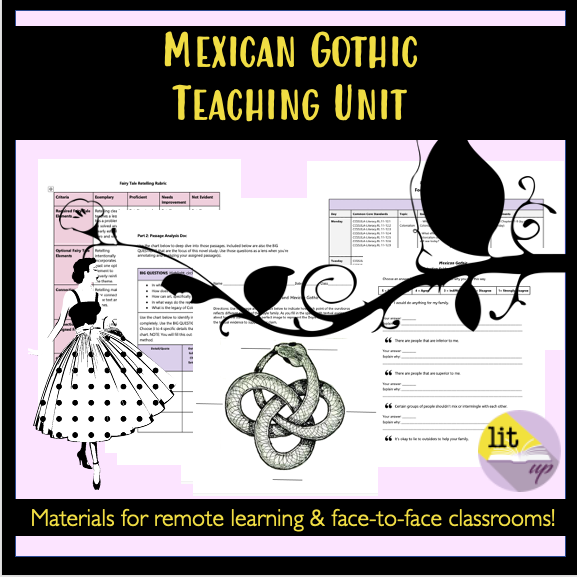
Mexican Gothic Teaching Unit by Lit Up What are some other contemporary novels you’ve added to update your curriculum?
Did you know I have a newsletter? It comes into your inbox once a week. Sign up here!
Looking for your next read? Check out my novel, With All My Love, I Wait.
- Why You Need to Be in a Book Club
Being part of a book club has been a gamechanger for my mental health.
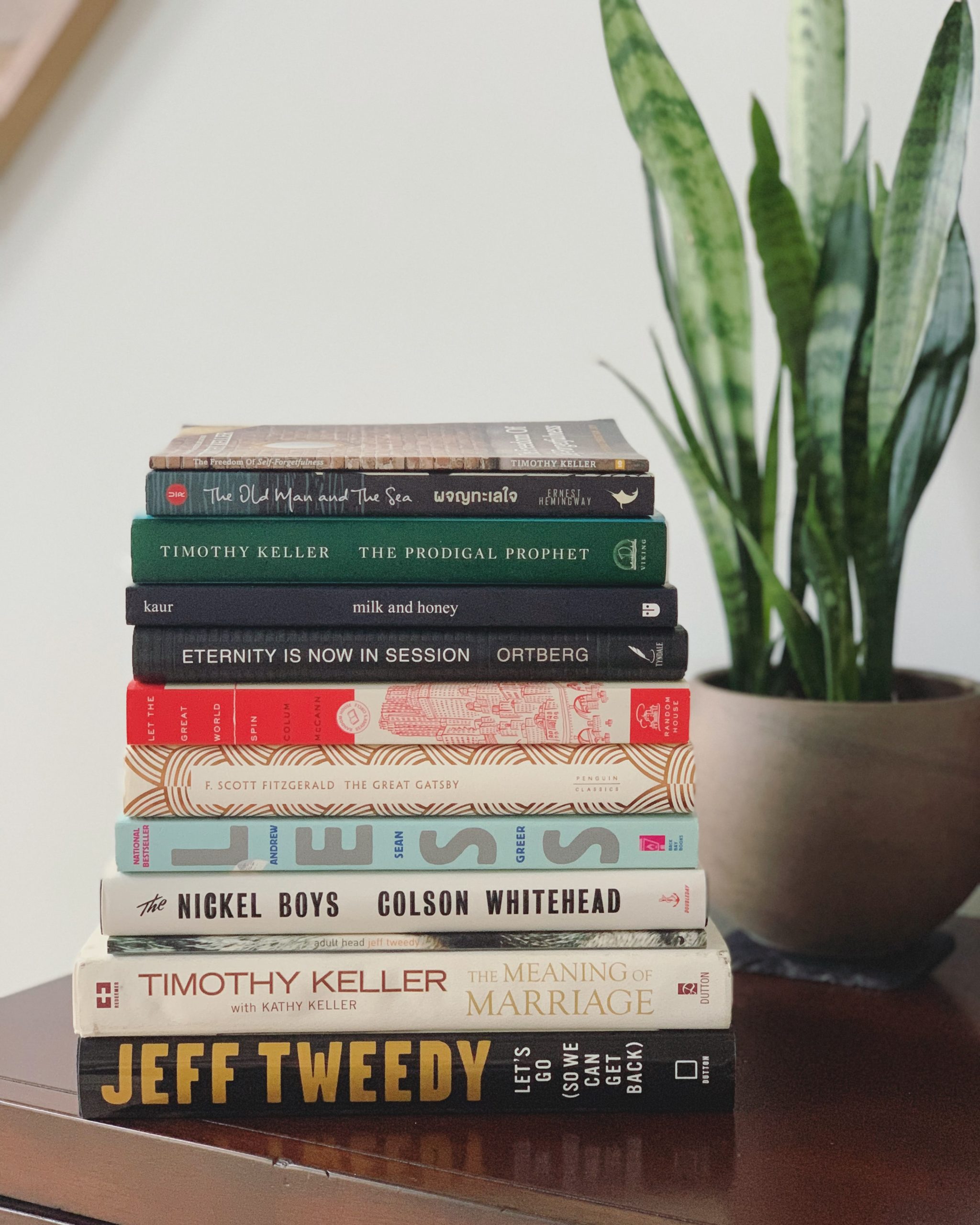
Photo by Tim Wildsmith on Unsplash For as long I can remember, I always thought I wanted to be the type of woman who was in a book club. I had visions of a Mad Men situation where a bunch of women holding martinis in fabulous clothes were sitting in a sunken living room talking about literature.
Then I went to grad school, got married, had a kid, and my dreams of ever being a Book Club Woman faded. I was teaching full-time high school and part-time online graduate writing courses. I was still reading, but not at the pace I wanted to be reading. And, the thing that I missed the most about grad school and undergrad English major life was talking about the books.
In February of 2020, I was graciously invited to a book club. If I’m being honest, I basically invited myself, but I was welcomed with open arms by a group of women much younger than me. When the pandemic hit, meetings were moved online. When the weather warmed up, we started meeting at a park.
In September, I couldn’t stop thinking about how much I missed talking to my grad school friends about books. I reached out to some of my girlfriends from my cohort. I’d gotten the idea to a Zoom book club after being invited weekly Zoom movie nights by a good friend from undergrad. Catching up with Matt and making new friends while watching rom-coms, early aughts comedies, and action movies, I suggested to my grad school friends we do a Zoom book club. And now I’m in two book clubs!
Like many, I hit a wall, emotionally, during the pandemic, and these two book clubs helped pull me out. Discussing art, politics, and maybe a little gossip, made the social losses more bearable. Between the local book club, weekly movie nights, and my grad school gal book club, I felt like I was a much more pleasant person to be around.
Book club feeds my English teacher self. It forces me to continue to read critically, which I’d do anyway, but being able to float theories and analysis is the kind of intellectual stimulation this nerd needs.
Not sure how to start or join a book club, here are few tips.
Look for local book clubs.
If you’re new to an area or don’t have a huge social circle, reach out to your local library and see if there are any book clubs you can join. Ask your coworkers if they are in a book club. There are also websites where local book clubs actively recruit members.
You don’t want to meet up with strangers? That’s cool.
Start your own book club.
When I started my grad school gals book club, I created a private Facebook group and messaged folks before adding them. The private Facebook group is an easy way to work out all the kinks.
Pick your first date.
My local book club meets every 4th or 5th Thursday. This makes it easy to know roughly when we’re going to meet. It’s always around the same time of the month. This also gives us enough time to read the books.
The Grad School Gals Book Club is a little different. I put out a poll after we’ve met in the Facebook group, and we vote on the best date. We meet roughly every 5 weeks.
Picking a Book
This is one of the best, but also most challenging parts.
I love the strategy that my local group does. Since the book club moves from one house to the next, the host puts out two books to choose from, then we do a quick vote.
The Grad School Gals do it differently. When I put the poll up, I ask for links to books that everyone wants to read. After about a week, I create a Google Form where we rank our choices by “Most Excited to Read to “please, God no.” Quick descriptions of each book are put at the start of the form to make it easier to rank. Once everyone has submitted their responses, the book with the most “Excited to Read” votes is the book of the month.
There are also a lot of lists online and resources to help you pick a book. Maybe you want to read books that have movies or TV shows greenlit, find a list! You can do things thematically or decide to read Pulitzer prize winners or local writers. Whatever you decide, there are so many great books to choose from.
Meetings
Run your meetings however you’d like. With virtual book clubs, it’s nice to go follow similar guidelines that you might in a Zoom meeting, muting your mic when you’re not talking, and all that.
At our local meeting, we go around and rate the book out 5, and then give a quick overview of our thoughts. As we do this, questions get asked and the discussion unfolds.
Book Club Kits
Some publishers include Book Club Kits. Before your meeting, it might a good idea to see if the book you’re reading has one.
Want to read With All My Love, I Wait with your book club. I’ve got a book club kit ready for you! Check it you here.
Final Thoughts
This past month, I didn’t finish the local book club choice. I read about 70 pages and then bailed. The book wasn’t for me, and I was in the middle of writing a book. I couldn’t devote the time to read it. Did that stop me from going to our meeting? No!
Not having read the book shouldn’t be a deterrent. Book club is about being social and enjoying the company of people who share similar interests.
So, if you’re on the fence, don’t be. Get your butt reading. Join or start a book club. You won’t regret it.
Did you know I have a newsletter? It comes into your inbox once a week. Sign up here!
Looking for your next read? Check out my novel, With All My Love, I Wait.
- First Week Rapport-Building Activity
Try these Reflect and Share Cards with Your Students

Photo by Brandi Redd on Unsplash Students are starting to trickle back into the classroom. For many, they haven’t seen the inside of a classroom in over a year. My son, for instance, spent the entire school year at home. He starts school in less than a week, and I’m curious to see how he adjusts to spending the day in a classroom with peers.
My son is very social. He has no problem introducing and interacting with peers. At the community pool, he will jump into a game and not care how much older or younger the kids are. He’s ready to socialize. I foresee many emails from teachers in the future regarding my son being social in the classroom. I apologize in advance.
Benefits of Building Rapport
Not all students are this way. I suspect as the year begins it will take many students to warm up and get comfortable with their peers. This makes classroom rapport something that teachers should be focused on. While the “learning gap” has been a major topic of conversation since the pandemic started, teachers know that if students trust each other learning happens more efficiently.
Reflect and Share Cards is an activity that I enjoy doing the first week of classes. This strategy gets students writing and talking. It also establishes the expectation that writing is a process. I have used this with all levels of high school from AP to standard to the elective classes that I’ve taught like Creative Writing. It is always a hit. I’ve never taught middle school, but I do believe it would work well with that age group as well.
Reflect and Share Cards Activity
To start, students are given five (5) notecards. I like to use big notecards (5 by 7). This gives the students room to flesh out their thoughts. If you have different colored cards, even better. If not, simply hand the students their cards and ask them to number them from 1 to 5.
The first card asks students to list topics of importance to them. I like to have them think in categories: important people, places, and events. They can also add topics they are deeply interested in or are experts on. Before you scoff about kids being experts on a topic, trust me, they are. Some have a vast knowledge of video games, pop culture, music, etc. Please don’t discount this about young people.
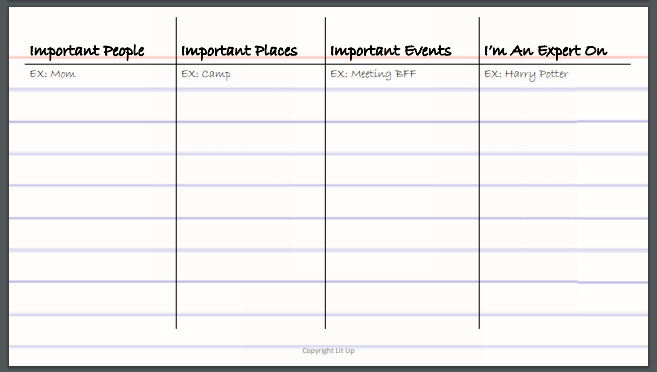
Sample Card from Lit Up After about 3 minutes of silently listing, they share their list with a partner. This person is their partner for the entire activity. After they share their list with their peer, they might want to add some things to their list. Give them about 1 minute to do this.
They then move on to card 2. On this card, they choose something from their list and write about it. They write for 3-4 minutes, then share. On the next card, they do the same. They can start on a new topic, or continue with the same topic. Maybe they change the point of view. With each card, their partner asks them a question.
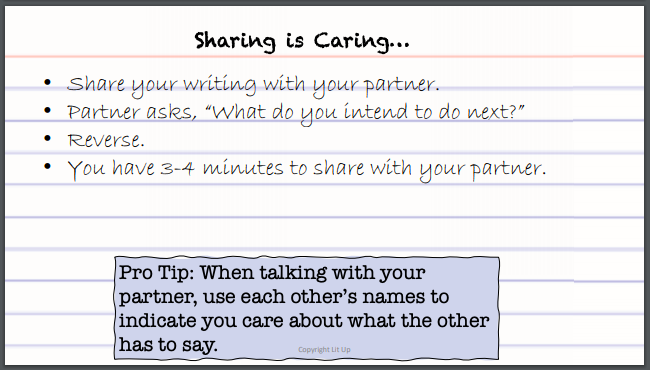
Sample Slide for Reflect and Share activity via Lit Up. I like to project the directions and prompts to help keep the students focused.
After they have completed all five cards, they choose one card to revise and polish. This polished version is what you collect. The revision activity can be one that you work on in class the following day after a brief overview of your expectations. Maybe you want to review MLA formatting or basic paragraph structure. If you teach creative writing, this is a great activity to introduce the personal essay.
Final Thoughts
I love watching this activity unfold. When the students are sharing their cards, I walk around and listen. It’s great to see how open and earnest they are with their peers. By the end of the activity, they have made an acquaintance they feel connected to which helps to kick off the community building. If you have your students journal, which I highly recommend, their topic card can be taped into their notebooks for reference. Now they have a list of important topics they can refer back to when they are stuck.
Want to try this activity with your students? You can purchase everything you need here. Just download and go. Don’t forget the notecards!
Did you know I have a newsletter? It comes into your inbox once a week. Sign up here!
Looking for your next read? Check out my novel, With All My Love, I Wait.
- The Secret to Making a Great Sandwich
It’s Back to School time, which means it’s time you get a handle on how to make the best sandwiches.
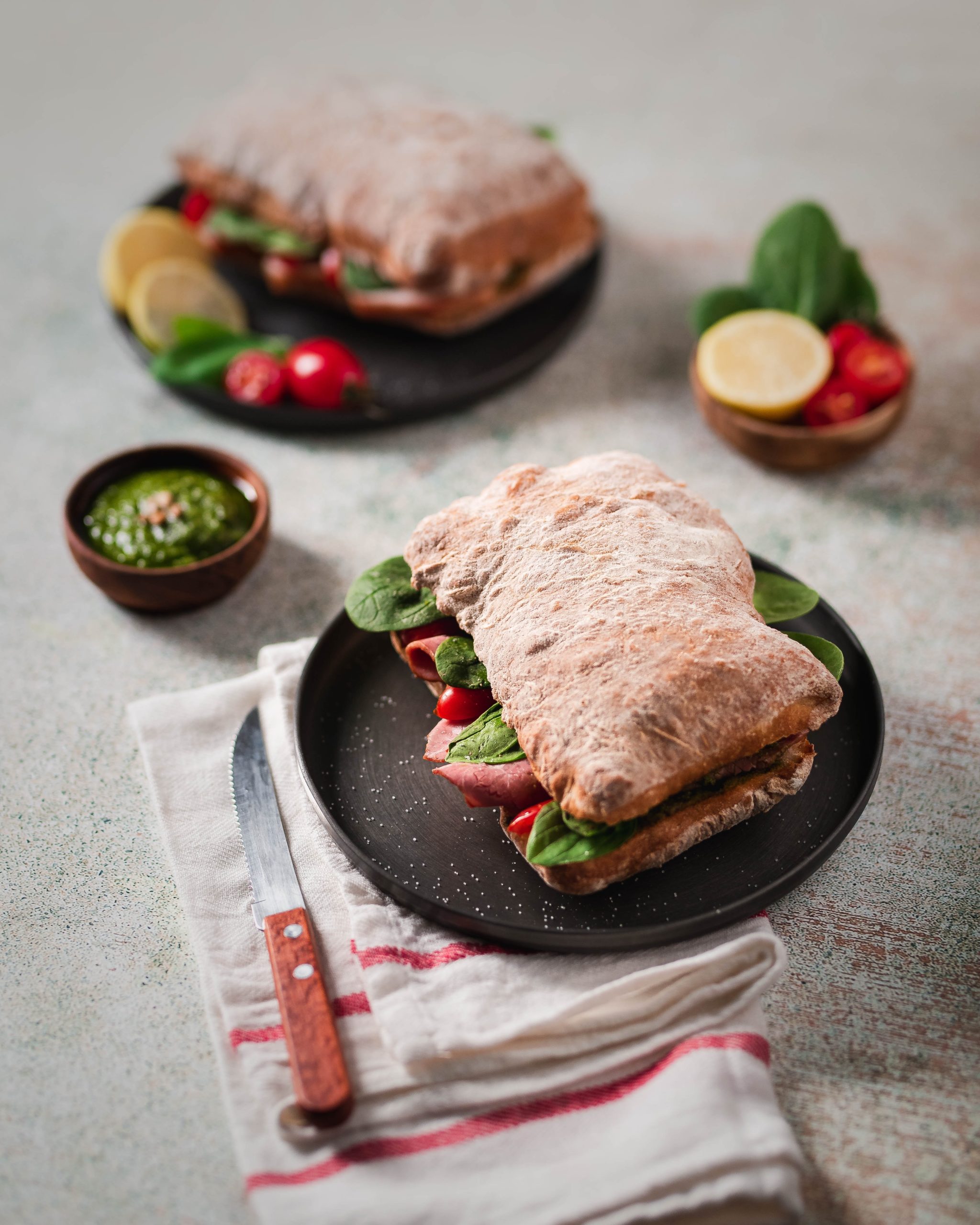
It’s back to school time, which means it’s also the time of year that parents and guardians are getting lunches ready for their children and themselves. I grew up with a dad who made the best sandwiches on earth. I don’t say this lightly. The man has a gift for making incredible sandwiches. Maybe it’s because he was a teacher for 40 years and sandwiches are a great whole meal to get a teacher from lunchtime to that final bell. Whatever the reason, I’m so grateful to have been born into a family where sandwiches were not just something slopped together. There was diligence and intention put into them.
So, not only am I going to reveal some of the tricks I’ve learned along the way, but I’m going to reveal a huge secret element that not only works in sandwiches but for any meal of the day. You’re welcome, friends.
Dad’s Sandwich Tips
You must use high-quality bread.
If there is one thing I learned growing up Italian, it’s that the caliber of ingredient matters. Don’t screw around with trash ingredients. Use or have less but make it the good stuff. Not all bread is created equally, so get a nice loaf from a local Italian bakery. If your grocery store has a solid bakery or has take-and-bake bread, use that. A nice crust adds a great layer of texture.
Are you packing your lunch the night before? You’ll be glad you used a good, hearty bread because it will stand the test of time in the refrigerator and your lunch box. Trust me.
Toast your sandwich.
As an impatient teenager, I used to lose my shit waiting on my dad to make sandwiches for us. On Saturday afternoons while my mom was working at the bridal shop she owned with my aunt, my dad would come inside from the Florida heat and take a break from the yard work and generally putzing around.
The man is a perfectionist, and when he makes sandwiches, he acts like he’s curing cancer or something. “Art cannot be rushed.” And I realize now that this is true, but when you’re 15, and your best friend wants to meet you at the beach, you just want to eat and run.
What took so damn long, you ask? The man was toasting the freaking bread. Sometimes, he’d use the toaster or toaster oven, but when Phil feels fancy, he oils the bread and gets a pan out, and for this, you wait.
Is it worth the wait? You bet your ass it is, but also, “hurry up, daddy, the movie at the mall starts in like 20 minutes!”
So, if you have time, invest in toasting your bread. You won’t be sorry when your sandwich is warm, and you take a bite and your bread has a crunch to it.
Texture matters.
If the crusty, toasted bread wasn’t a dead giveaway, my dad is big on texture. Sometimes though, you don’t have a fresh, crusty Italian loaf or time to toast your bread. What do you do then?
Get yourself some lettuce.
Picture yourself, an impatient teenager, home on an hour break from theater rehearsal, and your dad offers to make you a sandwich. At first, you think, “cool, Daddy, makes killer sandwiches.” You then realize that he must toast the bread, wash the lettuce, dry the lettuce, go get some fresh tomatoes from the garden, and grab the mortadella from the refrigerator in the garage. Sure, you help out as much as you can, but time is of the essence.
Anyway, if you don’t have Phil Panzera making your sandwiches and good ole fashioned white bread, throw a fresh, crispy romaine leaf onto your sandwich. You’ll get the added crunch and fiber. Like, it’s not a salad, but it’s still a vegetable.
Make it saucy.
Now, don’t get me wrong, you should absolutely not go overboard with sauce, and I should note, I’m using the word “sauce” really loosely here. What I’m trying to say is to not have a dry sandwich. Take the time to put a small dab of mayo or Miracle Whip on that sammy. If you’re like me and think mayo and Miracle Whip are kind of gross (save it, folks, I don’t want to get into a war about this. I’m 37, and I’ve yet to eat a sandwich and been glad it has mayo on it), use mustard or maybe a creamy salad dressing. I’m mostly a mustard, gal. It’s great for keeping things low calorie, and Dijon mustard is creamy and tangy.
I will say, my dad is really good about not going overboard with mayo. He uses just enough to add a light sheen to the bread, and since it’s toasted, it doesn’t get absorbed into the bread. Regardless, I swap mustard for mayo or a mashed-up avocado. If I have it on hand, I also love adding homemade pesto.
The secret element: roasted veggies.
Growing up, my mother used to roast a huge pan sheet of vegetables. She would use zucchini, bell peppers (you need to use the sweet yellow, red, and orange ones in addition to the more bitter green ones), eggplant, and onions. NOTE: It’s really important to cut the vegetables to about the same size so they cook evenly.
Before placing them on a sheet pan, she would put everything into a large bowl. She’d add what seemed like an insane amount of salt.
“What?” she’d asked when you looked at her cross-eyed, “Peppers and eggplant need lots of salt.”
And you know what? She was right. Don’t be afraid to season your vegetables. It makes a huge difference. When I’m making them, my rule of thumb is that the peppers need to be salted to the point where I could eat them as a salad. That’s when I know I’m good.
She’d then add pepper, garlic and onion powder, dried basil, dried oregano, and fresh parsley. If there was fresh oregano and basil around, she would use that instead.
Finally, and this is the most important part, she’d sprinkle the vegetable with Italian seasoned breadcrumbs.
The vegetables roast in the oven at 450 F until they start to caramelize.
I’m sorry I can’t give you an exact time. When I can smell them, I check them. That’s roughly about 30 minutes. I like them a little on the “burnt” side, like when the edges are just starting to crisp up.
The best thing about these roasted vegetables is not only do they make an incredible side dish, but they can be added to a salad, served with roasted or grilled sausage, added to a sandwich, or mixed into scrambled eggs.
I like making a big batch of them and adding them to whatever I’m making that week: salad, scrambled eggs, quiche, etc. When added to a sandwich the olive oil and juices from the vegetables soak into the bread. Then there is no need for mayo, mustard, or anything like that. Just the vegetables, meat cheese, and lettuce for the crunch.
What are your sandwich secrets?
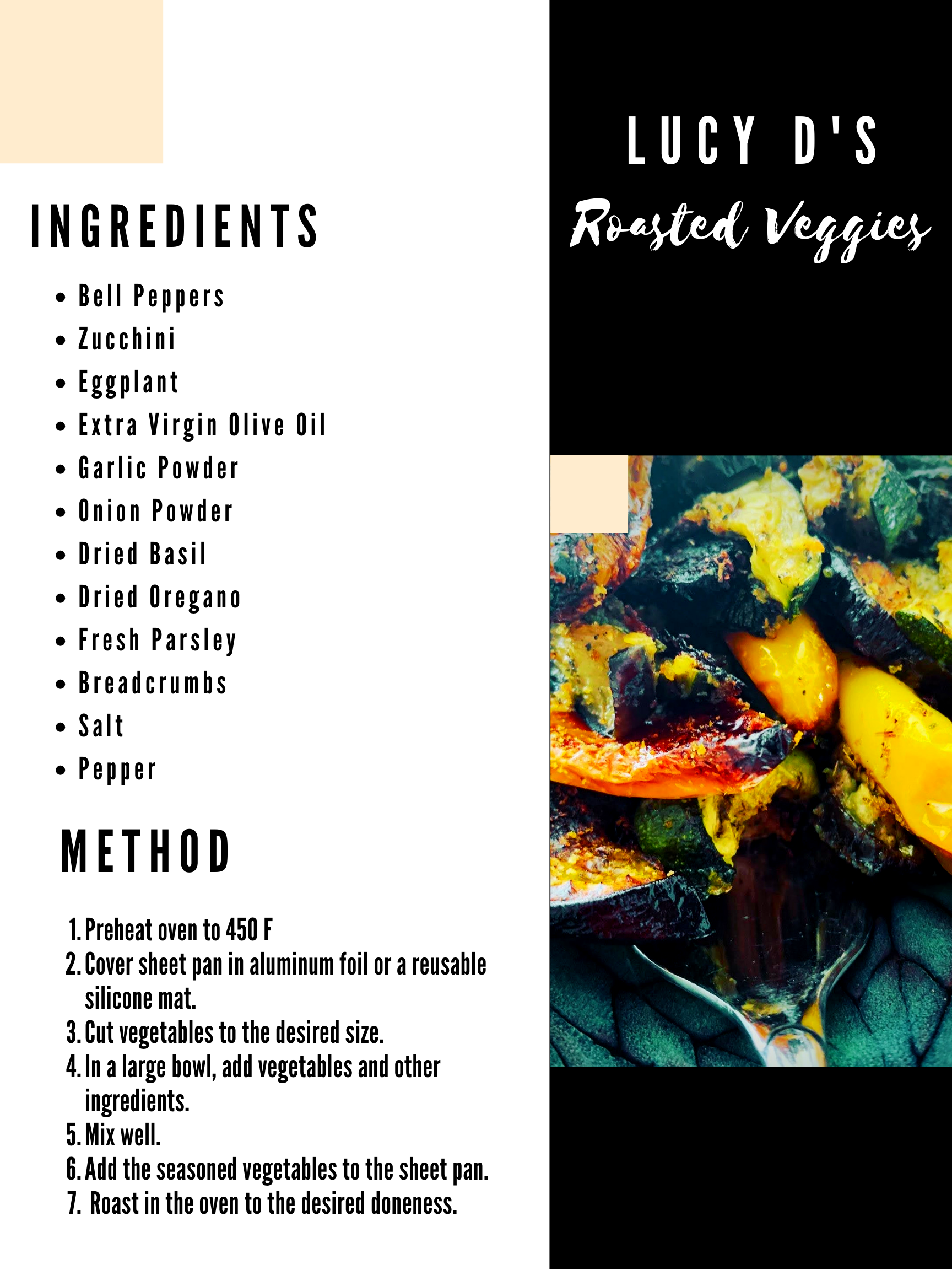
Did you know I have a newsletter? It comes into your inbox once a week. Sign up here!
Looking for your next read? Check out my novel, With All My Love, I Wait.
- Get to Know Your Students & Review Figurative Language with this Back to School Ice Breaker
Try this activity to get to know your students and review figurative language.

Photo by John Schnobrich on Unsplash For many teachers, the start of the school year not only means learning who your students are but also learning what your students know. If you’re looking for an activity that serves as a figurative language review, that gives you a writing sample, serves as an icebreaker activity, and builds classroom community, look no further.
Since the school year was quite a mess last year with hybrid, in-person, and virtual learning happening all once, you’re probably wondering, “what did my students learn last year?” This year promises to be a circus as well thanks to the Delta variant of COVID-19.
I’m a big proponent of controlling what I can control, and my classroom is something I have command of (for the most part).
Back to School Means Time to Review
To start the semester, I like to learn about students. What are their learning styles? What do they expect out of me as their teacher? How well can they write? What skills and terminology are still sharp? And where are they rusty?
During summer, it’s easy for students to forget some of the basic English classroom vernacular, specifically things like figurative language. While I’m confident that their previous English teachers taught it, I’m sure most of my students aren’t reading a novel over summer thinking, “That’s such a beautiful metaphor.” It’s unlikely they are watching Never Have I Ever on Netflix and thinking, “That Davie, she’s so hyperbolic.” In order to refresh their memories, this is an activity I use at the start of the term to job their minds and get them in the right mindset for my English class.
Step-by-Step Directions
Step 1
To start, students complete a “Getting to Know You Survey.” The survey asks a few questions about past learning experiences, goals for the course, and thoughts on classroom community. While students are filling out their surveys, I like to walk around with a bowl with the figurative language terms on slips of paper. If you’re looking to differentiate this assignment, give the students the definitions. For honors or older students, just provide the term. Once students have selected a slip of paper (I have them blindly choose), they now have their assigned term to define and use in the next step of the activity.
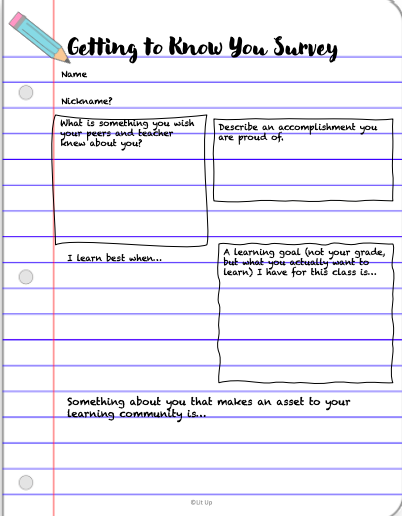
Screen capture from Getting to Know You Figurative Language Activity via Lit Up. Step 2
Next, students partner up. They talk through their surveys. I’m a big fan of Think, Pair, Share. After they’ve met and discussed their surveys, they unpack what they’ve learned on the back of their survey.
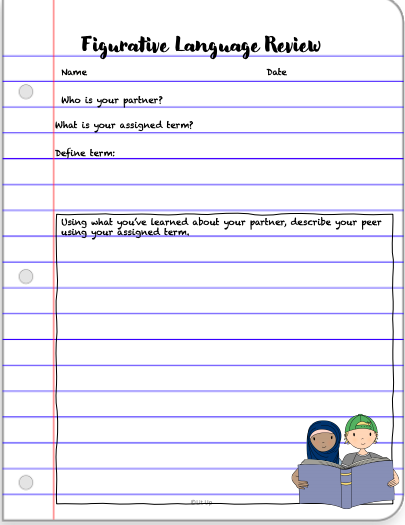
Screen capture from Getting to Know You Figurative Language Activity via Lit Up. Step 3
The final part of the handout includes a section where partners describe each other using their assigned figurative language device. This allows them to practice and more deeply understand the device. It also provides me with a view of how well they know their devices.
After students complete the handout, I provide the class with a review sheet. This can later be used as a study guide. It lists all the assigned devices. For AP or IB students, I would modify this list and ask for more complex devices. This version better serves eighth or ninth graders.
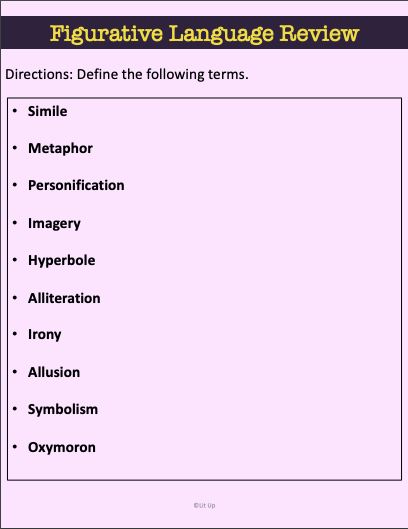
Screen capture from Getting to Know You Figurative Language Activity via Lit Up. If you’re looking for a way to do this virtually, I have an online discussion board prompt as part of the activity you can use here.
Don’t want to build all these resources? No worries. You can purchase everything you need to do this activity on day one of the school year here.
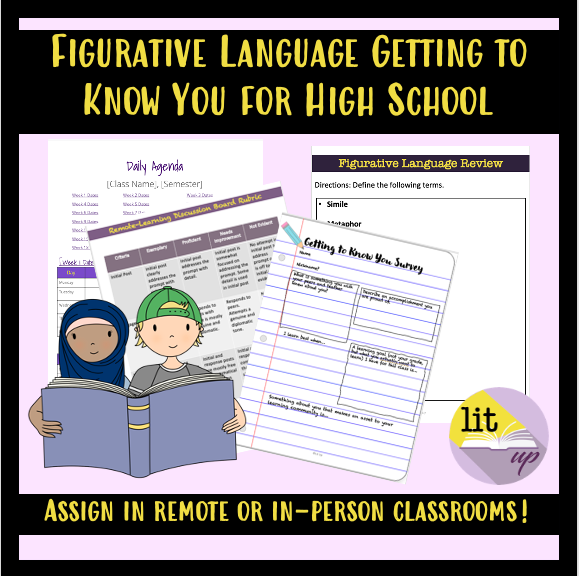
Figurative Language Getting to Know You Activity for High School via Lit Up. Did you know I have a newsletter? It comes into your inbox once a week. Sign up here!
Looking for your next read? Check out my novel, With All My Love, I Wait.
- Classroom Rules Are Meant to Be Broken
It’s long past time we stop with the incessant rules in the classroom.

Photo by NeONBRAND on Unsplash The day before my first day of teaching a veteran teacher reminded me to have my rules set and ready to go. “You can always loosen up, but you can never tighten up,” she said, wagging her finger.
While I do, mostly, agree with the idea of being a bit of a hardass at the start of the term, I do not subscribe to the adage that “You shouldn’t smile until October.” This old-school idea of being tough as nails or whatever other clichés, never really worked in my classroom. I do have a reputation for not putting up with the bullshit that teenagers try to pull, most of my students know, I’m really a softy.
Knowing I’m a softy means that having a 50-page syllabus with a million rules doesn’t serve anyone. Not to mention, it’s a waste of paper.
I’m not saying I don’t have very specific expectations, because I absolutely do. What I don’t have is one of those posters with a long list of rules like, “Raise your hand to speak,” or “Keep your hands, feet, and objects to yourself.”
Maybe I’m naïve, but by the time my students reach me in high school, those rules should be internalized. Instead of spending the first day going over a lengthy syllabus, students establish their own set of norms.
Before I go on, let me clarify one thing: rules and norms are different. I don’t have rules, but I do have policies. For instance, I have a no grooming policy and a no tuna fish with onions sub policy in my classroom. There is a clear procedure for using the hall pass and turning in late work. What I’m talking about here is establishing norms to build a nurturing classroom environment and community.
Since I teach English, the focus of those norms are based on how students want to see their classroom run with regard to reading, writing, and discussions. What do they expect of their peers and me when we are having heated conversations about controversial texts?
Having the students establish norms on day one is a great way to show them that they are accountable for their learning.
The Activity
First, I ask that students write down the answers to some questions their reading and writing history. Students who aren’t reading or writing at grade level often have negative reading and writing histories. Students tap into memories that have been both positive and negative and write them out.
After they’ve reflected on the past, they share with their peers and then eventually out to the class. It’s your classic “Think, Pair, Share” structure.
As a class, we make a list of what supports their reading and writing and what are barriers to their learning. From there, students silently make a list of norms. They share those norms with their groups, then as a class, we whittle these norms down.
The discussion is lively. Students share lovely stories about positive reading and writing experiences, but there are horror show stories, too. The conversation helps guide the students to make norms like, “Don’t dominate the discussion” or “Come to class prepared.”
The last thing we do on the first day is have students set small group norms. I like to create new groups every 2-3 weeks. I don’t know why, but I really love writing seating charts. It helps the students get to know each other and forces them to collaborate with different students throughout the semester. The students choose roles like taking attendance, making sure cell phones are parked, and collecting and passing back graded work. My goal with these roles and norms is to make sure that the classroom can run itself. It takes about two weeks, but with consistency, I’m able to get a smoothly run ship.
I use giant Post-Its to create norm posters for each class and have them up by the next day. When I remember, I ask a student who loves to draw or who has nice penmanship to write it up.
Like activity idea but don’t have time to get the materials ready? No problem. Here’s everything you need to stop making classroom rules and start building classroom community. NOTE: There’s even an option to use it in a virtual classroom.
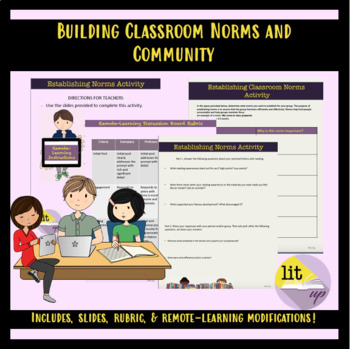
Results
I’ve been using this strategy for about 7 years, and I love it. I don’t have to worry about putting up lame, elementary school-style posters up with rules like, “Raise your hand” and “Stay seated.” This activity starts the semester with the expectation that students are adults. The result: they mostly act more like adults.
Does this put an end to all classroom management issues?
Of course not. What it does, however, is allow the students to hold each other accountable for their learning. When group members don’t come prepared, they remind each other of the contracts they’ve made. When students dominate during the discussion, I point them to the norms they established.
In the end, those rules about raising hands and staying seated get broken, but the students own their learning because it’s their classroom, and I’m mostly there to facilitate their learning.
Did you know I have a newsletter? It comes into your inbox once a week. Sign up here!
Not ready to go back to school and still looking for a summer read? Check out my novel, With All My Love, I Wait.
- 5 Things Teachers Can Do in the Last Stretch of Summer
Fall is coming. What can you do to stay refreshed and ready?
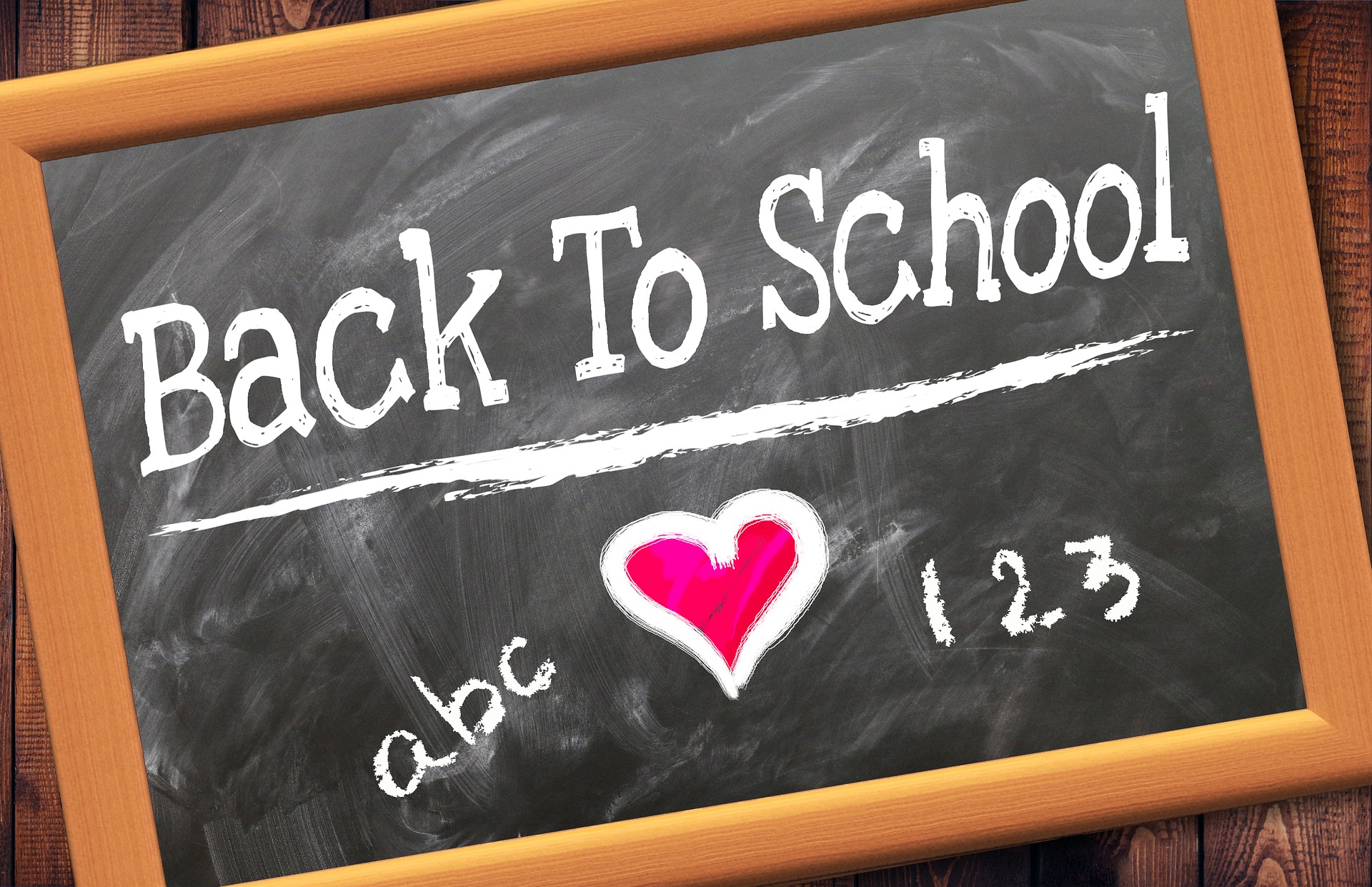
Image by Thanks for your Like • donations welcome from Pixabay I know you don’t want to hear this, teacher friends, but summer is almost over. Have you noticed the fun donut-shaped floaties have been replaced with school supplies at Target?
I’m not saying it’s time to abandon the pool or put down your beach read, but here are some things I like to do as the school year starts to wind up and get going.
1. Create a cursory pacing guide for each prep.
If you’re new to your school or maybe you’re teaching a different course from the past it’s time to reach out to your PLC and get some answers to important questions. What are the anchor texts for each unit? What skills are you going to be teaching in each unit? And in what ways are you given the freedom to do what you want in your classroom? Knowing the answers to these questions, regardless of whether you’ve been teaching a class for twenty years or if this is your first year, will help you create that pacing guide.
Want something more detailed that you can give to your students? Here’s a link to my free daily agenda.
2. Make a list of what you need for your classroom.
I’m not talking about things you’re going to need in December, friends. I’m talking about what you’ll need to survive that first week or two. A few years ago, I started teaching in a school district that required that all English students follow Kelly Gallagher and Penny Kittle’s Writer’s Notebook strategy from 180 Days: Two Teachers and the Quest to Engage and Empower Adolescents. This meant teachers used part of their supply stipend to purchase over 150 composition notebooks. Having a list of the other materials I would need like notecards for my “ Reflect and Share” Activity was also necessary, not to mention wanting to update my classroom library and so on. Having a list helps me stay on track and not get overwhelmed during that opening week when you’re scrambling to get your classroom together and attending required PD, while also watching all those safety videos and setting up the digital end of your classroom. Are we stressed yet?
3. Read two books: one for pleasure and one for teaching
I love reading for pleasure and summer is the best time of year to knock out reading those books that everyone is talking about during the school year when I’m grading papers and not getting enough sleep. It’s also a great time to read that new novel you’ve been itching to teach or some PD. Because I’m an English teacher, I usually read at least one or two novels I’m going to make a unit for and one book for PD.
4. Order a few new lewks for work
Maybe it’s the forever-student in me but getting school clothes was always a highlight of summer coming to an end when I was a student. That excitement never went away when I became a teacher. When the school year starts, it’s similar to the way January does with new year’s resolutions. I optimistically think about how “this is the year…” I’ll wear cute shoes to work and maybe consistently wear lipstick (the lipstick was definitely a pre-COVID goal). Since you definitely won’t have time to run out and thoughtfully pick out some new outfits to start the school year and set the tone (anyone else wear heels the first week to establish you’re a badass bitch then revert to your ballet flats in week two after the students are scared of you?), get them now as the new fall trends are being put out in stores.
5. Make a list of your professional goals for the year
I write my goals every day. Does it do anything? I don’t know, but I like that it keeps my goals at the forefront of my mind. While you don’t need to do this daily, consider writing your professional goals while you’re still refreshed from those watermelon gin-fizzes. Don’t wait until the end of the day the Friday before school starts, you’re worn down from PD, tired af, and feeling like if Mary doesn’t stop hogging the copier with her 25-page syllabus you’re going to burn the place down. Do it now, while you’re still optimistic and can be objective. Feeling fancy? Make a wallpaper for your work computer on Canva so you can see your goals all the time.
What are some ways you like to start getting ready for the school year?
Did you know I have a newsletter? It comes into your inbox once a week. Sign up here!
